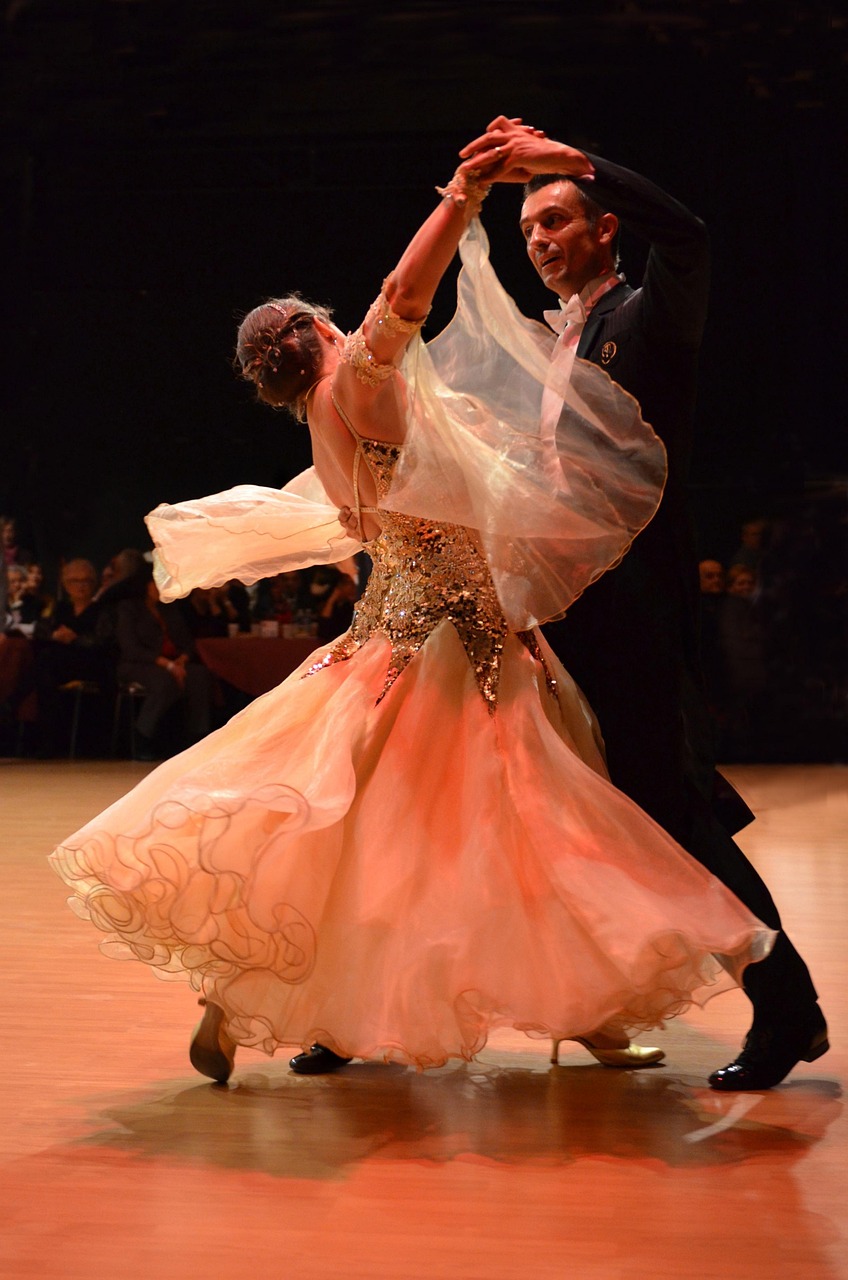
No piece of classical music grips my ballet-dancer’s imagination like Aram Khachaturian’s “Waltz” from his Masquerade suite. Like his Piano Concerto that I blogged about HERE in 2017, it doesn’t start so much as drop the listener smack into a musical extravaganza, where the lines between listener and music have been erased and, oh Lord, I’m inside it and waltzing and whirling, and for as long as the music lasts, I don’t want to be any place else in the world.
As a much younger Classical Girl, a lonely teen with glasses and braces and few friends, I loved this mental space as much as I loved slipping inside the fictional world of books (hint: a LOT). I’d waltz, sometimes just in my head, sometimes full-out in the spaciousness of the upstairs area with its two ample-sized bedrooms connected by a hallway. In my head, it was a sumptuous ballroom and I whirled amid women in beautiful, flowing satin dresses that flared out as their elegantly attired partners waltzed them around and around. It was a sublime feeling. Friends? Who needed them, when I had Khachaturian and his “Waltz”?
Let’s stop right there and give it a listen. (The Waltz is the first of five movements, all of which are excellent.)
Nice, huh?
Khachaturian has a magical touch, like Erich Korngold and Nikolai Rimsky-Korsakov, to create music that is suffused with emotion, energy and passion. There’s conflict and resolution within the same musical passage. It’s almost cinematic, the way the music can tell a story, and so vividly. Bill Parker in Building a Classical Music Library puts it more eloquently:
“Khachaturian’s forms are loose and rhapsodic, his melodies long and sinuous, his orchestrations barbarically colorful—thus arousing the wrath of musicologists, but making a direct and welcome appeal to the average listener.”
A bit about the composer. Aram Khachaturian was born in 1903 to ethnic Armenian parents in Tbilisi, Republic of Georgia, where he was also raised. He was self-taught on the piano in his youth, and only later did he receive formal training, in Moscow. Music, however, surrounded him from an early age and made a profound impact on him. I wrote more extensively about the composer’s younger years in the above-referenced blog so I won’t duplicate that. In short, he identified strongly with his ethnic Armenian heritage and eventually became a proud, card-carrying member of the Communist Party, eager to support the Soviet Union with the creation of music that celebrated and embraced his region’s folkloric roots.
in 1941, Khachaturian composed Masquerade as incidental music for a new staging of Mikhail Lermontov’s 1835 four-act play, The Masquerade, at Moscow’s Vakhtangov Theatre. (Coincidentally, the Soviet film, Masquerade came out the same year, based on the same original play, but the music is by Venedikt Pushkov and not Khachaturian.) In a nutshell, Masquerade tells an Othello-like story about a mixup at a masked ball, a flirtation, a scheming woman having borrowed another’s bracelet, leading the main character Arbenin to accuse his beloved wife Nina (the bracelet’s owner) of infidelity and ultimately poisoning her to death, after which he discovers she’d been innocent. A rather nasty story, but it helps explain to listeners why there is a dark undertone to the gorgeous waltz music (is it weird that I just love the dark undertone and welcome its complexity within the waltz?).
Khachaturian composed throughout the Soviet regime of Joseph Stalin, but unlike the other two Soviet titans of the classical music world, Shostakovich and Prokofiev, he did not rail against the constraints of the regime, with its strict mandates on what to glorify (The People!), how to sound (loud and bombastic and triumphant) and how to comport oneself as an artist (meekly, humbly, gratefully, cravenly). But even so, in 1948 he found himself grouped with his musical peers, with charges leveled against them by the Soviet regime. Ironically, too, as Khachaturian, in his 1947 “Symphonic Poem” (later named the Third Symphony), had intended to applaud and honor communism. “I wanted to write the kind of composition in which the public would feel my unwritten program without an announcement,” he explained. “I wanted this work to express the Soviet people’s joy and pride in their great and mighty country.”
It did not work out that way. Hindsight, as they say, is 20-20; he should have included his message in program notes.
Oops.

Author Harold C. Schonberg, in The Lives of the Great Composers, recounts the events that led to the devastating 1948 Central Committee Resolution and denouncement.
“Prokofiev and virtually every important Soviet composer of the day were attacked by the regime following the premiere of Vano Muradeli’s 1947 opera, The Great Friendship. It was reviewed as historically and ideologically incorrect, with “inexpressive, poor, unharmonious, muddled music … confused and discordant, built on continuous dissonances and ear-splitting combinations of sounds.” Three months later the Central Committee of the Communist Party held a meeting at which charges were brought against Muradeli, Prokofiev, Shostakovich, Khachaturian and a half-dozen others. The Central Committee published a Resolution accusing all these composers of formalism, “anti-democratic tendencies that are alien to the Soviet people and its artistic tastes,” and of writing music “strongly reminiscent of the spirit of contemporary modernistic bourgeois music of “Europe and America.”
This was a big, big, big problem. This could spell out the end for each composer’s career (maybe even their life). What could one do in Soviet Russia under Stalin, besides apologize in the most extravagantly craven fashion?
Muradeli: “How could it have happened that I failed to introduce a single folk song into the score of my opera? … I have before me a definite task, to realize fully unequivocally the seriousness of my creative errors, and to correct these errors with ideological honesty in my future work.”
Shostakovich: “I am deeply grateful for … all the criticism contained in the resolution. … I shall with more determination work on the musical depiction of the images of the heroic Soviet people.”
Prokofiev: “The Resolution … has separated decayed tissue in the composers’ creative production from the healthy part … The Resolution is particularly important because it demonstrates that the formalist movement is alien to the Soviet people.”
Khachaturian: “How could it happen that I have come to formalism in my art? … I want to warn those comrades who, like myself, hoped that their music, which is not understood by the people today, will be understood by future generations tomorrow.”
Tough times to be a creative artist.
But let’s not end this on a dark, political note. Khachaturian was a cheerful, largely optimistic communist who continued to embrace the Soviet Union’s ideology. His music spoke of the people and to the people. The ballet, Gayane, is set on a collective farm, after all, and the ballet, Spartacus, for which he composed sublime music, features a heroic “man of the people.” And while were on the subject of Spartacus, let’s end with another WOW favorite of mine by Khachaturian. I have a hunch you’ve heard it before, even if you can’t say exactly where. (This was precisely my experience up to a year ago.) It’s got a very romantic, lush melodic line that the whole movement hews to. Here it is, the “Adagio of Spartacus and Phrygia.” And for my ballet readers, let’s make it extra fun for you and embed the ballet version. Featuring dancers Nina Kaptsova and Carlos Acosta, Act III of the ballet, performed at Paris’s Palais Garnier in 2008, choreography by Yuri Grigorivich.
I LOVE the Adagio of Spartacus & Phrygia. And you’re right, I didn’t know where I knew the music from, I must have seen this when I was much younger, my mum was into ballet stuff.
There was a BBC television drama series in the 1970’s, The Onedin Line, that used the Adagio during the show’s opening credits.
Jim, yes! And DotRR, thanks for sharing your comments!